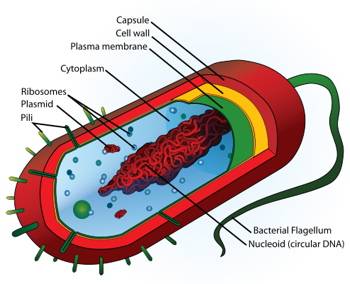Prokaryotic Cell Structure
Online Biology Dictionary

|
| Typical prokaryotic cell structure (Enlarged view) |
Prokaryotic cell structure is simpler than that of a eukaryote. Whereas a eukaryotic cell has multiple chromosomes that are contained in a membrane-bounded nucleus and, usually, a variety of other membrane-bounded organelles, prokaryotes lack such structures.
In prokaryotes, also known as bacteria or germs, there is a single, circular chromosome, which is sometimes called a genophore to distinguish it from eukaryotic chromosomes. Another name for this structure is the nucleoid region (or simply the nucleoid). It appears as a snarl of fibers visible in under an electron microscope. In comparison with a eukaryote there is very little protein associated with a prokaryotic chromosome.
In addition to this single major chromosome, a prokaryotic cell may also include much smaller rings of DNA called plasmids. Plamids often provide the bacterial cell with genes it needs to survive in particular adverse environments, for example, in the presence of antibiotics or in the absence of certain nutrients.
Prokaryotic ribosomes are smaller than eukaryotic ribosomes. And they are so different from their eukaryotic counterparts that they can be targeted by drugs that have no adverse effect on eukaryotes.
Almost all prokaryotes have a cell wall outside the plasma membrane. It maintains the shape of the cell and prevents the cell from bursting in a hypotonic solution (i.e., one with a lower concentration of solutes than the cell's cytoplasm).
Unlike the cell walls of plants, the wall of a prokaryotic cell contains peptidoglycan, which consists of sugar polymers cross-linked by short polypeptides. The fact that only bacterial cell walls contain this substance provides another avenue for targeting them with antibiotics that won't harm their eukaryotic host. Gram-positive bacteria have lots of peptidoglycan in their cell walls, gram-negative bacteria have less.